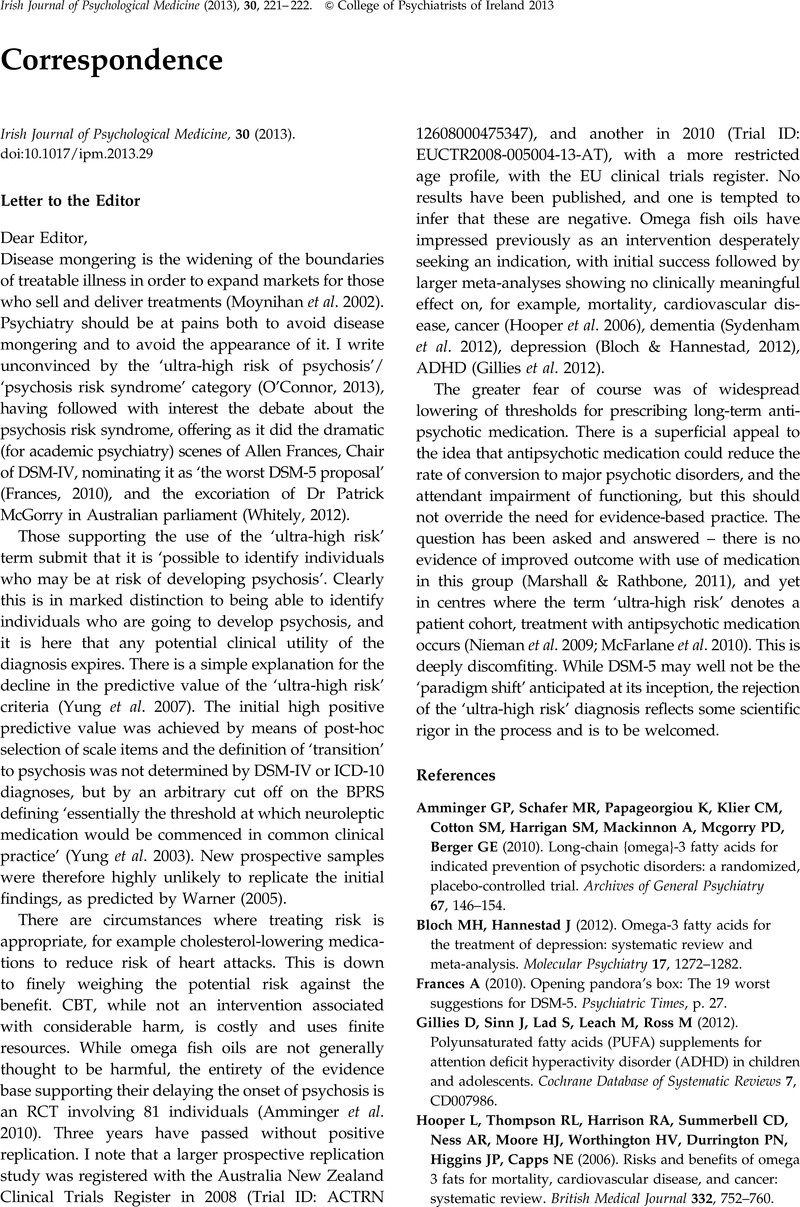No CrossRef data available.
Article contents
Letter to the Editor
Published online by Cambridge University Press: 18 July 2013
Abstract
An abstract is not available for this content so a preview has been provided. Please use the Get access link above for information on how to access this content.

- Type
- Correpondence
- Information
- Copyright
- Copyright © College of Psychiatrists of Ireland 2013
References
Amminger, GP, Schafer, MR, Papageorgiou, K, Klier, CM, Cotton, SM, Harrigan, SM, Mackinnon, A, Mcgorry, PD, Berger, GE (2010). Long-chain {omega}-3 fatty acids for indicated prevention of psychotic disorders: a randomized, placebo-controlled trial. Archives of General Psychiatry 67, 146–154.CrossRefGoogle ScholarPubMed
Bloch, MH, Hannestad, J (2012). Omega-3 fatty acids for the treatment of depression: systematic review and meta-analysis. Molecular Psychiatry 17, 1272–1282.CrossRefGoogle ScholarPubMed
Frances, A (2010). Opening pandora's box: The 19 worst suggestions for DSM-5. Psychiatric Times, p. 27.Google Scholar
Gillies, D, Sinn, J, Lad, S, Leach, M, Ross, M (2012). Polyunsaturated fatty acids (PUFA) supplements for attention deficit hyperactivity disorder (ADHD) in children and adolescents. Cochrane Database of Systematic Reviews 7, CD007986.CrossRefGoogle Scholar
Hooper, L, Thompson, RL, Harrison, RA, Summerbell, CD, Ness, AR, Moore, HJ, Worthington, HV, Durrington, PN, Higgins, JP, Capps, NE (2006). Risks and benefits of omega 3 fats for mortality, cardiovascular disease, and cancer: systematic review. British Medical Journal 332, 752–760.CrossRefGoogle ScholarPubMed
Marshall, M, Rathbone, J (2011). Early intervention for psychosis. Cochrane Database of Systematic Reviews 6, CD004718.Google Scholar
Mcfarlane, WR, Cook, WL, Downing, D, Verdi, MB, Woodberry, KA, Ruff, A (2010). Portland identification and early referral: a community-based system for identifying and treating youths at high risk of psychosis. Psychiatric Services 61, 512–515.CrossRefGoogle ScholarPubMed
Moynihan, R, Heath, I, Henry, D (2002). Selling sickness: the pharmaceutical industry and disease mongering. British Medical Journal 324, 886–891.CrossRefGoogle ScholarPubMed
Nieman, DH, Rike, WH, Becker, HE, Dingemans, PM, Van Amelsvoort, TA, De Haan, L, Van der Gaag, M, Denys, DA, Linszen, DH (2009). Prescription of antipsychotic medication to patients at ultra high risk of developing psychosis. International Clinical Psychopharmacology 24, 223–228.CrossRefGoogle ScholarPubMed
O'connor, K (2013). Research in young people at ultra-high risk for psychosis: a review of the current evidence. Irish Journal of Psychological Medicine 30, 77–89.CrossRefGoogle ScholarPubMed
Sydenham, E, Dangour, A, Lim, W (2012). Fish oils for the prevention of dementia in older people. Cochrane Database of Systematic Reviews 6, CD005379.Google Scholar
Warner, R (2005). Problems with early and very early intervention in psychosis. The British Journal of Psychiatry 187, s104–s107.CrossRefGoogle Scholar
Whitely, M (2012). Whitely slams Patrick McGorry for disease mongering. Online video clip. Youtube, 6 October 2012. Accessed 26 June 2013.Google Scholar
Yung, AR, Phillips, LJ, Yuen, HP, Francey, SM, Mcfarlane, CA, Hallgren, M, Mcgorry, PD (2003). Psychosis prediction: 12-month follow up of a high-risk (“prodromal”) group. Schizophrenia Research 60, 21–32.CrossRefGoogle ScholarPubMed
Yung, AR, Yuen, HP, Berger, G, Francey, S, Hung, T-C, Nelson, B, Phillips, L, Mcgorry, P (2007). Declining transition rate in ultra high risk (prodromal) services: dilution or reduction of risk? Schizophrenia Bulletin 33, 673–681.CrossRefGoogle ScholarPubMed


